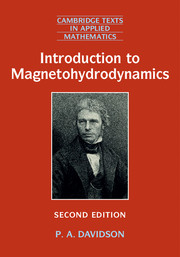3653 results in ebooks in fluid mechanics
6 - Magnetohydrodynamics
-
- Book:
- Introduction to Plasma Physics
- Published online:
- 16 March 2017
- Print publication:
- 20 February 2017, pp 186-220
-
- Chapter
- Export citation
Dedication
-
- Book:
- Introduction to Plasma Physics
- Published online:
- 16 March 2017
- Print publication:
- 20 February 2017, pp v-vi
-
- Chapter
- Export citation
8 - Discontinuities and Shock Waves
-
- Book:
- Introduction to Plasma Physics
- Published online:
- 16 March 2017
- Print publication:
- 20 February 2017, pp 281-318
-
- Chapter
- Export citation

Introduction to Magnetohydrodynamics
-
- Published online:
- 09 February 2017
- Print publication:
- 22 December 2016
Dedication
-
- Book:
- Introduction to Magnetohydrodynamics
- Published online:
- 09 February 2017
- Print publication:
- 22 December 2016, pp v-vi
-
- Chapter
- Export citation
Copyright page
-
- Book:
- Introduction to Magnetohydrodynamics
- Published online:
- 09 February 2017
- Print publication:
- 22 December 2016, pp iv-iv
-
- Chapter
- Export citation
Part IV - Applications in Physics
-
- Book:
- Introduction to Magnetohydrodynamics
- Published online:
- 09 February 2017
- Print publication:
- 22 December 2016, pp 399-540
-
- Chapter
- Export citation
Appendices
-
- Book:
- Introduction to Magnetohydrodynamics
- Published online:
- 09 February 2017
- Print publication:
- 22 December 2016, pp 541-543
-
- Chapter
- Export citation
13 - MHD Instabilities in Aluminium Reduction Cells
- from Part III - Applications in Engineering and Materials
-
- Book:
- Introduction to Magnetohydrodynamics
- Published online:
- 09 February 2017
- Print publication:
- 22 December 2016, pp 374-398
-
- Chapter
- Export citation
3 - A First Course in Fluid Dynamics
- from Part I - From Maxwell’s Equations to Magnetohydrodynamics
-
- Book:
- Introduction to Magnetohydrodynamics
- Published online:
- 09 February 2017
- Print publication:
- 22 December 2016, pp 57-111
-
- Chapter
- Export citation
Appendix B - Physical Properties of Liquid Metals
-
- Book:
- Introduction to Magnetohydrodynamics
- Published online:
- 09 February 2017
- Print publication:
- 22 December 2016, pp 543-543
-
- Chapter
- Export citation
7 - Dynamics at High Magnetic Reynolds Numbers
- from Part II - The Fundamentals of Incompressible MHD
-
- Book:
- Introduction to Magnetohydrodynamics
- Published online:
- 09 February 2017
- Print publication:
- 22 December 2016, pp 185-227
-
- Chapter
- Export citation
6 - Dynamics at Low Magnetic Reynolds Numbers
- from Part II - The Fundamentals of Incompressible MHD
-
- Book:
- Introduction to Magnetohydrodynamics
- Published online:
- 09 February 2017
- Print publication:
- 22 December 2016, pp 144-184
-
- Chapter
- Export citation
8 - An Introduction to Turbulence
- from Part II - The Fundamentals of Incompressible MHD
-
- Book:
- Introduction to Magnetohydrodynamics
- Published online:
- 09 February 2017
- Print publication:
- 22 December 2016, pp 228-276
-
- Chapter
- Export citation
4 - The Governing Equations of MHD
- from Part I - From Maxwell’s Equations to Magnetohydrodynamics
-
- Book:
- Introduction to Magnetohydrodynamics
- Published online:
- 09 February 2017
- Print publication:
- 22 December 2016, pp 112-120
-
- Chapter
- Export citation
Contents
-
- Book:
- Introduction to Magnetohydrodynamics
- Published online:
- 09 February 2017
- Print publication:
- 22 December 2016, pp vii-xiv
-
- Chapter
- Export citation
Part I - From Maxwell’s Equations to Magnetohydrodynamics
-
- Book:
- Introduction to Magnetohydrodynamics
- Published online:
- 09 February 2017
- Print publication:
- 22 December 2016, pp 1-120
-
- Chapter
- Export citation
5 - Kinematics: Advection, Diffusion and Intensification of Magnetic Fields
- from Part II - The Fundamentals of Incompressible MHD
-
- Book:
- Introduction to Magnetohydrodynamics
- Published online:
- 09 February 2017
- Print publication:
- 22 December 2016, pp 123-143
-
- Chapter
- Export citation
Preface to the Second Edition
-
- Book:
- Introduction to Magnetohydrodynamics
- Published online:
- 09 February 2017
- Print publication:
- 22 December 2016, pp xv-xvi
-
- Chapter
- Export citation
References
-
- Book:
- Introduction to Magnetohydrodynamics
- Published online:
- 09 February 2017
- Print publication:
- 22 December 2016, pp 544-550
-
- Chapter
- Export citation
